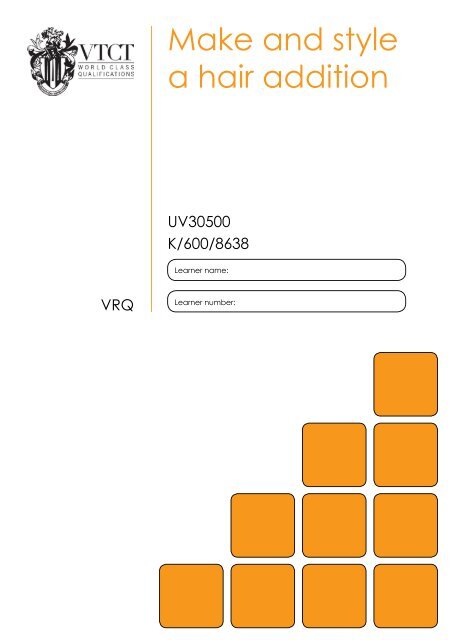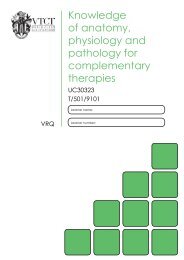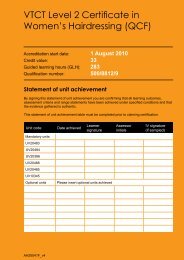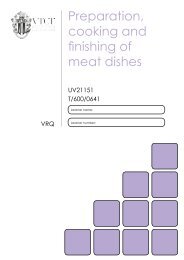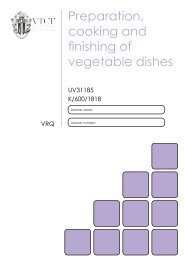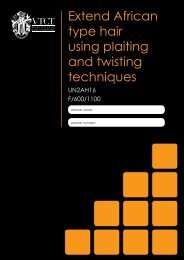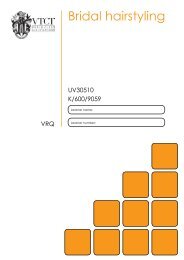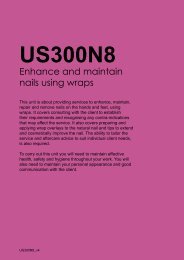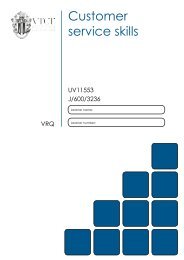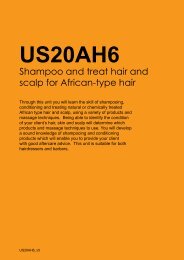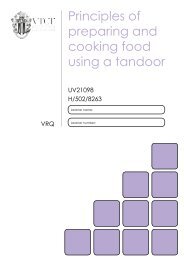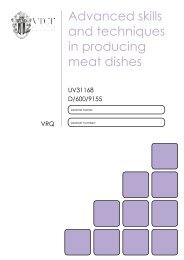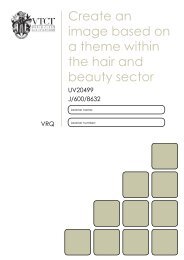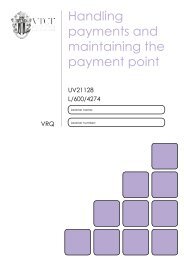Be able to make and style a hair addition - VTCT
Be able to make and style a hair addition - VTCT
Be able to make and style a hair addition - VTCT
You also want an ePaper? Increase the reach of your titles
YUMPU automatically turns print PDFs into web optimized ePapers that Google loves.
VRQ<br />
Make <strong>and</strong> <strong>style</strong><br />
a <strong>hair</strong> <strong>addition</strong><br />
UV30500<br />
K/600/8638<br />
Learner name:<br />
Learner number:
Statement of unit achievement<br />
<strong>VTCT</strong> is the specialist awarding body for the Hairdressing, <strong>Be</strong>auty Therapy,<br />
Complementary Therapy <strong>and</strong> Sport <strong>and</strong> Active Leisure sec<strong>to</strong>rs, with over 45<br />
years of experience.<br />
<strong>VTCT</strong> is an awarding body regulated by national organisations including<br />
Ofqual, SQA, DCELLS <strong>and</strong> CCEA.<br />
<strong>VTCT</strong> is a registered charity investing in education <strong>and</strong> skills but also giving <strong>to</strong><br />
good causes in the area of facial disfigurement.<br />
By signing this statement of unit achievement you are confirming that all learning outcomes, assessment<br />
criteria <strong>and</strong> range statements have been achieved under specified conditions <strong>and</strong> that the evidence<br />
gathered is authentic.<br />
This statement of unit achievement t<strong>able</strong> must be completed prior <strong>to</strong> claiming certification.<br />
Unit code Date achieved Learner signature<br />
Assessor tracking t<strong>able</strong><br />
Assessor name Assessor signature<br />
Assessor<br />
initials<br />
Assessors<br />
initials<br />
IV signature<br />
(if sampled)<br />
All assessors using this Record of Assessment book must complete this t<strong>able</strong>. This is required for<br />
verification purposes.<br />
Assessor number<br />
(optional)
UV30500<br />
Make <strong>and</strong> <strong>style</strong> a <strong>hair</strong> <strong>addition</strong><br />
The aim of this unit is <strong>to</strong> develop your skills <strong>to</strong> <strong>make</strong> a<br />
simple <strong>hair</strong> <strong>addition</strong> using the wig making technique of<br />
weaving a weft. This unit will take you through the planning<br />
stage of creating a mood board, producing your <strong>hair</strong><br />
<strong>addition</strong>, styling the weft using permanent techniques <strong>and</strong><br />
then incorporating it in<strong>to</strong> your <strong>hair</strong> design. This is a very<br />
intricate technique <strong>and</strong> will need a high degree of manual<br />
dexterity.<br />
This unit is suit<strong>able</strong> for both <strong>hair</strong>dressers <strong>and</strong> barbers.<br />
UV30500_v5
Level<br />
Credit value<br />
GLH<br />
3<br />
7<br />
60<br />
Observation(s)<br />
2<br />
External paper(s)<br />
0
Make <strong>and</strong> <strong>style</strong> a <strong>hair</strong> <strong>addition</strong><br />
Learning outcomes Evidence requirements<br />
On completion of this unit you will:<br />
1. <strong>Be</strong> <strong>able</strong> <strong>to</strong> <strong>make</strong> <strong>and</strong> <strong>style</strong> a <strong>hair</strong> <strong>addition</strong><br />
2. <strong>Be</strong> <strong>able</strong> <strong>to</strong> develop a mood board<br />
1. Environment<br />
Evidence for this unit must be gathered in a<br />
real or realistic working environment.<br />
2. Simulation<br />
Simulation is not allowed in this unit. All<br />
‘Observation’ outcomes must be on real<br />
clients.<br />
3. Observation outcomes<br />
Competent performance of ‘Observation’<br />
outcomes must be demonstrated <strong>to</strong> your<br />
assessor on at least two occasions.<br />
4. Range<br />
All ranges must be practically demonstrated<br />
or other forms of evidence produced <strong>to</strong><br />
show they have been covered.<br />
5. Knowledge outcomes<br />
There must be evidence that you possess<br />
all the knowledge <strong>and</strong> underst<strong>and</strong>ing<br />
listed in the ‘Knowledge’ section of this<br />
unit. This evidence may include projects,<br />
assignments, case studies, reflective<br />
accounts, oral/written questioning <strong>and</strong>/or<br />
other forms of evidence.<br />
6. Tu<strong>to</strong>r/Assessor guidance<br />
You will be guided by your tu<strong>to</strong>r/assessor<br />
on how <strong>to</strong> achieve learning outcomes <strong>and</strong><br />
ranges in this unit. All outcomes <strong>and</strong> ranges<br />
must be achieved.<br />
7. External paper<br />
There is no external paper requirement for<br />
this unit.<br />
UV30500<br />
3
4<br />
Achieving observations<br />
<strong>and</strong> range<br />
Achieving observation outcomes<br />
Your assessor will observe your performance<br />
of practical tasks. The minimum number<br />
of observations required is indicated in the<br />
evidence requirements section of this unit.<br />
Criteria may not always naturally occur during<br />
a practical observation. In such instances you<br />
will be asked questions <strong>to</strong> demonstrate your<br />
competence in this area. Your assessor will<br />
document the criteria that have been achieved<br />
through oral questioning.<br />
Your assessor will sign off an outcome when all<br />
criteria have been competently achieved in a<br />
single client service.<br />
Achieving range<br />
The range section indicates what must<br />
be covered. Ranges should be practically<br />
demonstrated as part of an observation. Where<br />
this is not possible other forms of evidence may<br />
be produced. All ranges must be covered.<br />
Your assessor will document the portfolio<br />
reference once a range has been competently<br />
achieved.<br />
UV30500<br />
Maximum service times<br />
There are no maximum service times that apply<br />
<strong>to</strong> this unit.
Outcome 1<br />
<strong>Be</strong> <strong>able</strong> <strong>to</strong> <strong>make</strong> <strong>and</strong> <strong>style</strong> a <strong>hair</strong> <strong>addition</strong><br />
You can:<br />
a. Communicate <strong>and</strong> behave in a professional<br />
manner<br />
b. Select products, <strong>to</strong>ols, equipment <strong>and</strong><br />
accessories <strong>to</strong> achieve the desired effect<br />
c. Produce a woven weft of <strong>hair</strong> on a weaving<br />
frame<br />
d. Produce a final finished <strong>hair</strong> <strong>addition</strong><br />
e. Style the woven weft of <strong>hair</strong> using<br />
permanent styling techniques<br />
f. Present the final finished <strong>style</strong>d <strong>hair</strong><br />
<strong>addition</strong><br />
g. Provide suit<strong>able</strong> aftercare advice<br />
h. Record techniques, products, <strong>to</strong>ols,<br />
equipment <strong>and</strong> accessories used <strong>to</strong> achieve<br />
the finished <strong>hair</strong> design<br />
i. Follow safe <strong>and</strong> hygienic working practices<br />
j. Evaluate the finished <strong>hair</strong> design<br />
*May be assessed through oral questioning.<br />
Observations<br />
Observation 1 2 Optional<br />
Date achieved<br />
Criteria questioned orally<br />
Portfolio reference<br />
Assessor initials<br />
Learner signature<br />
UV30500 5
6<br />
*You must practically demonstrate that you have:<br />
Range<br />
Considered all influencing fac<strong>to</strong>rs Portfolio reference<br />
Desired finished result<br />
Haircut<br />
Hair length<br />
Hair texture<br />
Hair density<br />
Hair colour<br />
Degree of curl<br />
Head size <strong>and</strong> face shape <strong>and</strong> features<br />
Produced all types of weft Portfolio reference<br />
2 str<strong>and</strong><br />
3 str<strong>and</strong><br />
Short <strong>hair</strong> (minimum 15 cm)<br />
Long <strong>hair</strong> (minimum 20 cm)<br />
Given all types of advice Portfolio reference<br />
Suit<strong>able</strong> aftercare products <strong>and</strong> their use<br />
Maintenance of the <strong>style</strong><br />
*It is strongly recommended that all range items are practically demonstrated. Where this is not<br />
possible, other forms of evidence may be produced <strong>to</strong> demonstrate competence.<br />
UV30500
Achieving knowledge outcomes<br />
You will be guided by your tu<strong>to</strong>r <strong>and</strong> assessor<br />
on the evidence that needs <strong>to</strong> be produced.<br />
Your knowledge <strong>and</strong> underst<strong>and</strong>ing will be<br />
assessed using the assessment methods listed<br />
below:<br />
• Observed work<br />
• Witness statements<br />
• Audio-visual media<br />
• Evidence of prior learning or attainment<br />
• Written questions<br />
• Oral questions<br />
• Assignments<br />
• Case studies<br />
Developing knowledge<br />
Where possible your assessor will integrate<br />
knowledge outcomes in<strong>to</strong> practical observations<br />
through oral questioning.<br />
UV30500 7
8<br />
Knowledge<br />
Outcome 1<br />
<strong>Be</strong> <strong>able</strong> <strong>to</strong> <strong>make</strong> <strong>and</strong> <strong>style</strong> a <strong>hair</strong> <strong>addition</strong><br />
You can:<br />
k. Describe how <strong>to</strong> maintain <strong>hair</strong> <strong>addition</strong>s<br />
l. Describe <strong>hair</strong> styling techniques for <strong>hair</strong> <strong>addition</strong>s for men <strong>and</strong><br />
women<br />
m. Describe the aftercare advice that should be provided<br />
n. Outline safe <strong>and</strong> hygienic working practices<br />
o. State how <strong>to</strong> communicate <strong>and</strong> behave within a salon environment<br />
*Assessor initials <strong>to</strong> be inserted if orally questioned.<br />
Requirements highlighted in white are assessed in the external paper.<br />
UV30500<br />
Portfolio reference /<br />
Assessor initials*
Outcome 2<br />
<strong>Be</strong> <strong>able</strong> <strong>to</strong> develop a mood board<br />
You can:<br />
a. Develop a mood board which incorporates woven <strong>hair</strong> <strong>addition</strong>s<br />
<strong>and</strong> accessories, <strong>and</strong> takes in<strong>to</strong> account influencing fac<strong>to</strong>rs<br />
b. Describe how <strong>to</strong> develop a mood board<br />
c. Outline the purpose of a mood board<br />
d. Outline how <strong>to</strong> present a mood board which incorporates <strong>hair</strong><br />
<strong>addition</strong>s, accessories <strong>and</strong> ornamentation<br />
e. Describe the main <strong>style</strong>s of wigs <strong>and</strong> <strong>hair</strong> <strong>addition</strong>s used in<br />
his<strong>to</strong>rical civilisations <strong>and</strong> cultures<br />
f. Explain how wigs <strong>and</strong> <strong>hair</strong> <strong>addition</strong>s are used in modern society<br />
g. Describe the employment opportunities for wig making <strong>and</strong> <strong>hair</strong><br />
<strong>addition</strong>s specialists<br />
h. Describe the influencing fac<strong>to</strong>rs that need <strong>to</strong> be considered when<br />
creating a <strong>hair</strong> <strong>addition</strong><br />
*Assessor initials <strong>to</strong> be inserted if orally questioned.<br />
Requirements highlighted in white are assessed in the external paper.<br />
Portfolio reference /<br />
Assessor initials*<br />
UV30500 9
10<br />
Unit content<br />
This section provides guidance on the recommended knowledge <strong>and</strong> skills required <strong>to</strong> en<strong>able</strong> you<br />
<strong>to</strong> achieve each of the learning outcomes in this unit. Your tu<strong>to</strong>r/assessor will ensure you have the<br />
opportunity <strong>to</strong> cover all of the unit content.<br />
Outcome 1: <strong>Be</strong> <strong>able</strong> <strong>to</strong> <strong>make</strong> <strong>and</strong> <strong>style</strong> a <strong>hair</strong> <strong>addition</strong><br />
Professional communication in a salon<br />
environment: Try <strong>to</strong> avoid technical<br />
language, always respond, consider client<br />
confidentiality.<br />
Verbal – speaking (<strong>to</strong>ne of voice, the<br />
language you use, how quickly <strong>and</strong><br />
clearly), questioning (open, closed,<br />
probing).<br />
Non-verbal – body language, positive<br />
attitude (your posture, facial expressions,<br />
h<strong>and</strong> gestures, the distance you st<strong>and</strong>),<br />
listening (be patient, try <strong>to</strong> underst<strong>and</strong>).<br />
Written – visual aids, magazines, client<br />
records.<br />
<strong>Be</strong>have professionally in a salon<br />
environment: Follow health <strong>and</strong> safety<br />
practice <strong>and</strong> procedure, salon code of<br />
conduct, respect others, value client(s),<br />
co-operate with others (be sympathetic,<br />
fair, not aggressive), use appropriate<br />
language, avoid gossip, maintain<br />
confidentiality, polite/cheerful <strong>and</strong> friendly<br />
manner (friendly facial expressions, open<br />
body language, positive attitude, eye<br />
contact), sensible behaviour, team work,<br />
take pride in work, be punctual, employer<br />
<strong>and</strong> client loyalty.<br />
Products, <strong>to</strong>ols, equipment <strong>and</strong><br />
accessories used:<br />
Products – use manufacturers’ instructions<br />
for product use on wigs <strong>and</strong> <strong>hair</strong> pieces,<br />
using the wrong product can <strong>make</strong> the <strong>hair</strong><br />
look matted <strong>and</strong> lank or have no effect,<br />
avoid product build-up.<br />
Natural <strong>hair</strong> – cleaning fluids<br />
UV30500<br />
(tricholerthylene fluids), neutralising rinse,<br />
styling lotions/gels, mousse, setting lotion,<br />
<strong>hair</strong> spray, dressing cream.<br />
Synthetic <strong>hair</strong> – only use shampoo <strong>and</strong><br />
water <strong>to</strong> clean <strong>hair</strong>, (wax, serum or shine<br />
spray can be used).<br />
Tools <strong>and</strong> equipment – clamps, weaving<br />
sticks, drawing brushes, bees wax, jockey/<br />
clip, <strong>hair</strong>, brigoudi, jigger, pinching irons,<br />
postiche oven, heater, boiling water,<br />
drying cabinet, malle<strong>able</strong> blocks of varying<br />
sizes, polythene <strong>to</strong> cover the block, block<br />
holder, postiche pins, personal protective<br />
equipment (gloves, <strong>to</strong>wels), tape, rollers,<br />
clips, brushes, scissors, razor, cutting<br />
combs, hood dryer, h<strong>and</strong> dryer.<br />
Accessories – tissue paper, end paper,<br />
thread, weaving silk, paper, bowl, back<br />
mirror, <strong>hair</strong> net, wig box, neck brush,<br />
ornamentation (feathers, bows, but<strong>to</strong>ns,<br />
beads, ribbon, <strong>addition</strong>al <strong>hair</strong>, tiara,<br />
combs).<br />
How <strong>to</strong> produce a woven weft of <strong>hair</strong><br />
on a weaving frame: Set up the weaving<br />
frame, number the silks, place prepared<br />
<strong>hair</strong> in brushes, draw off a fine section, hold<br />
in one h<strong>and</strong>, the <strong>hair</strong> is woven in <strong>and</strong> out of<br />
the silks, alternating the odd number silks<br />
in one direction with even number silks in<br />
the opposite direction, slide the weaving<br />
close <strong>to</strong> previously woven <strong>hair</strong>, place the<br />
jockey clip close <strong>to</strong> the weft, starting <strong>and</strong><br />
finishing knots are required for all methods.<br />
Density of weft – number of times the <strong>hair</strong><br />
is woven.
Outcome 1: <strong>Be</strong> <strong>able</strong> <strong>to</strong> <strong>make</strong> <strong>and</strong> <strong>style</strong> a <strong>hair</strong> <strong>addition</strong> (continued)<br />
2 string fly weft – the finest of all weaving,<br />
a neat finish.<br />
Twice in weaving – slightly thicker than<br />
once.<br />
Thrice in weaving – thickest of all.<br />
Diamond mesh – has a wire in the weft.<br />
Types of <strong>hair</strong> <strong>addition</strong>s:<br />
Pin curl weft – take a wire pin (looks like<br />
a roller pin), using pair of pliers bend up<br />
the ends, hook this in<strong>to</strong> the weaving at the<br />
finished knot end <strong>and</strong> thread a needle with<br />
length of silk, match <strong>hair</strong> colour, stitch the<br />
pin curl through centre of weft/pin wire,<br />
cover metal pin completely, finish off with a<br />
silk cap. The sewing thread is continually<br />
wound around so there is a smooth edge<br />
between wire <strong>and</strong> <strong>hair</strong>, cover with tissue<br />
paper <strong>and</strong> press the cap between heated<br />
pinching irons.<br />
The <strong>to</strong>rsade – piece of postiche that curls<br />
at 2 ends, secured in centre.<br />
Diamond mesh – normally worn on the<br />
crown, can be moulded <strong>and</strong> stitched in<strong>to</strong> a<br />
pattern.<br />
Pin wave – a flat weft stitched in by blanket<br />
stitch, <strong>and</strong> finished with 6 loops from one<br />
side <strong>to</strong> the other.<br />
The marteau weft – has 2 loops <strong>and</strong> is<br />
stitched flat, both ends attached by grips.<br />
Pin curls – attached by placing a grip<br />
through the loop.<br />
Torsades/double loop clusters – one<br />
loop is formed at either end so can be<br />
attached by a grip.<br />
Permanent styling techniques: Frisure<br />
force is the name given <strong>to</strong> permanent<br />
curling.<br />
Equipment required – bigoudis (wooden<br />
curlers various sizes), comb <strong>to</strong> assist with<br />
winding, pan of boiling water <strong>to</strong> <strong>make</strong><br />
the permanent curl, drawing brushes for<br />
holding the <strong>hair</strong>, drying cabinet for drying<br />
the curls, pre-heat before use, jigger <strong>to</strong><br />
hold the <strong>hair</strong>, end papers <strong>to</strong> protect <strong>hair</strong><br />
ends neatly, <strong>to</strong>wels <strong>to</strong> blot the <strong>hair</strong>, scissors<br />
<strong>and</strong> thread, when tying the <strong>hair</strong> in<strong>to</strong><br />
bundles, water jug.<br />
Method – secure the <strong>hair</strong> in the jigger,<br />
dampen <strong>hair</strong> with water (add small amount<br />
of acetatic acid, <strong>to</strong> help soften the <strong>hair</strong>),<br />
place end paper around the <strong>hair</strong> ends,<br />
evenly wind on<strong>to</strong> the bigoudi, secure<br />
the <strong>hair</strong> with the thread, place in a pan<br />
of boiling water for 30 minutes, remove<br />
carefully, blot on <strong>to</strong>wel <strong>to</strong> remove excess<br />
water, place in the postiche oven until dry,<br />
cut the thread <strong>and</strong> remove the paper, pin<br />
curls may be <strong>style</strong>d by placing in pinching<br />
irons, permanent crimping can also be<br />
achieved, this <strong>hair</strong> is used for crepe pads<br />
or pompadour rolls, present the curl on a<br />
piece of A4 card or by attaching wired weft/<br />
<strong>hair</strong> piece in<strong>to</strong> the <strong>hair</strong>.<br />
Provide suit<strong>able</strong> aftercare advice:<br />
Important part of service, avoid technical<br />
language, maintain eye contact, suggest/<br />
advise/recommend, provide information.<br />
Maintenance – frequency of visit, regular<br />
services, minimise chemical treatments,<br />
correct use of electrical equipment, product<br />
use <strong>and</strong> demonstration, s<strong>to</strong>ps them matting<br />
or loosening.<br />
Product information <strong>and</strong> use –<br />
demonstration, relevant literature/leaflet.<br />
Cleaning – after 12-15 wears synthetic or<br />
real <strong>hair</strong>.<br />
Styling tips – techniques, <strong>to</strong>ols, electrical<br />
UV30500 11
12<br />
Outcome 1: <strong>Be</strong> <strong>able</strong> <strong>to</strong> <strong>make</strong> <strong>and</strong> <strong>style</strong> a <strong>hair</strong> <strong>addition</strong> (continued)<br />
appliance settings.<br />
Life span of <strong>addition</strong> – approx 9 months.<br />
How <strong>to</strong> maintain <strong>hair</strong> <strong>addition</strong>s: Keep<br />
<strong>hair</strong> piece either pinned <strong>to</strong> a block or in<br />
a moth proof box, when not in use clean<br />
regularly, do not wear <strong>to</strong> bed, remove<br />
properly (avoid pulling on natural <strong>hair</strong>),<br />
attach safely <strong>to</strong> avoid damage <strong>to</strong> own <strong>hair</strong><br />
(remove grips gently), brush with correct<br />
<strong>to</strong>ols, clean with correct products.<br />
Complete client records: Manual or<br />
computer, contact information, type<br />
<strong>and</strong> colour of <strong>hair</strong>, the cost, <strong>hair</strong> piece<br />
required, <strong>to</strong>ols <strong>and</strong> equipment, product<br />
usage, date of service, changes <strong>to</strong><br />
service, contra-indications, problems,<br />
cost of service, test results, aftercare,<br />
requirements for <strong>hair</strong> piece or wig<br />
(measurements), <strong>style</strong> required, estimated<br />
price of work <strong>to</strong> be carried out, date of<br />
fitting, the colour (attach a sample).<br />
Salon health <strong>and</strong> safety legislation<br />
<strong>and</strong> regulations: Health <strong>and</strong> safety at<br />
work, control of substances hazardous<br />
<strong>to</strong> health, reporting of injuries, diseases<br />
<strong>and</strong> dangerous occurrences, personal<br />
protective equipment, electricity at work,<br />
manual h<strong>and</strong>ling, supply of goods <strong>and</strong><br />
services, trade description, data protection,<br />
employers’ liability (compulsory insurance),<br />
occupiers’ liability, local by-laws (set by<br />
council), salon rules, code of conduct,<br />
observance by all staff.<br />
Evaluate the service/results: What<br />
worked well/what did not, benefits,<br />
compare against original brief, end result,<br />
client satisfaction, draw conclusions.<br />
Hair styling techniques for <strong>hair</strong><br />
<strong>addition</strong>s:<br />
Synthetic <strong>hair</strong> – must only be washed in<br />
UV30500<br />
soapy water <strong>and</strong> left <strong>to</strong> dry naturally, they<br />
cannot be <strong>style</strong>d, as the <strong>hair</strong> will melt,<br />
pre-set <strong>style</strong> will bounce back when dry.<br />
Natural <strong>hair</strong>:<br />
Roller setting – pin the postiche on a soft<br />
block, choose roller size (for <strong>style</strong>), dampen<br />
<strong>hair</strong> lightly, use neutralising lotion (if<br />
working on white <strong>hair</strong>), take clean sections<br />
(avoid pulling the knots), set in the required<br />
<strong>style</strong>, secure the rollers (without pulling the<br />
foundation <strong>and</strong> causing dis<strong>to</strong>rtion), cover<br />
with a net, use tissue paper <strong>to</strong> prevent<br />
discolouration (if working on white <strong>hair</strong>),<br />
dry the postiche in a warm oven or hood<br />
dryer (white <strong>hair</strong> naturally or cool oven),<br />
after drying allow <strong>to</strong> cool, dressing out (with<br />
great care <strong>to</strong> avoid damage <strong>to</strong> the knots),<br />
carefully place net over the finished <strong>style</strong><br />
<strong>and</strong> return wig <strong>to</strong> the oven <strong>to</strong> set the <strong>style</strong>,<br />
dressing cream <strong>to</strong> control the <strong>hair</strong>. Hair<br />
<strong>addition</strong>s placed in <strong>style</strong> before the final<br />
dressing of the <strong>hair</strong>, <strong>make</strong> a large pin curl<br />
with slightly backcombed <strong>hair</strong> <strong>and</strong> slide the<br />
comb in which is attached <strong>to</strong> the weft, if<br />
the weft has no combs use grips <strong>to</strong> attach<br />
through the loops.<br />
Blow drying – may be used, be careful<br />
of disturbing the knots, dampen the <strong>hair</strong><br />
lightly, if working with white <strong>hair</strong> use a<br />
neutralising lotion, blow dry as normal<br />
(gently).
Outcome 2: <strong>Be</strong> <strong>able</strong> <strong>to</strong> develop a mood board<br />
Mood board: Presentation <strong>to</strong>ol used <strong>to</strong><br />
display ideas/thought process, a poster,<br />
collage, collection of ideas, s<strong>to</strong>ry behind<br />
an image, resources can include pictures,<br />
text, objects, materials, accessories, woven<br />
<strong>hair</strong>, (gives visual effect of design, ability <strong>to</strong><br />
identify texture/feel/colour of woven <strong>hair</strong>,<br />
<strong>to</strong>uches all senses).<br />
How <strong>to</strong> develop a mood board: Hard<br />
copy or electronic, begin with a brief/plan,<br />
focus on developing the sensory aspect,<br />
assemble a mosaic of source material,<br />
inspiring <strong>and</strong> relevant, create a collage,<br />
refer <strong>to</strong> brief, be creative, pho<strong>to</strong>graph large<br />
items that cannot be added, include <strong>hair</strong><br />
swatches, <strong>addition</strong>s, range of expressive<br />
visual media (magazines, newspapers,<br />
leaflets, pho<strong>to</strong>graphs, leaflets collected<br />
from shops, galleries, museums, your own<br />
sketches, copies from other artists <strong>and</strong><br />
designers), samples of (fabric, wallpaper,<br />
thread wool, sample cards from DIY<br />
s<strong>to</strong>res), natural materials (leaves, flowers,<br />
stems, seed, pods, shells, feathers,<br />
s<strong>to</strong>nes).<br />
Purpose of a mood board: Communicate<br />
<strong>to</strong> target audience, set the scene/s<strong>to</strong>ryline,<br />
share concept, express mood/feelings<br />
behind image, visual aid, launch a project.<br />
How <strong>to</strong> present a mood board: Formal/<br />
informal presentation, an actual board<br />
or via computer software, PowerPoint<br />
presentation, <strong>addition</strong>al props/clothes/<br />
<strong>make</strong>-up/accessories/jewellery, prepared<br />
speech/prompt cards, professionalism,<br />
varied communication skills (body<br />
language, <strong>to</strong>ne, clarity, projection of voice),<br />
interpersonal skills.<br />
The his<strong>to</strong>rical use of wigs <strong>and</strong> <strong>hair</strong><br />
<strong>addition</strong>s: Ancient cultures that used<br />
wigs (Assyrians, Phoenicians, Greeks <strong>and</strong><br />
Romans).<br />
Ancient Egyptians – used as a shield<br />
from sun (shaved head), all same <strong>style</strong>.<br />
Japanese – Geisha, elaborate <strong>style</strong>s using<br />
ornamentation, men’s wigs (Perukes/<br />
periwigs).<br />
King Louis XIII of France – Roman <strong>style</strong>.<br />
16th century – fair, wavy on the <strong>to</strong>p, tied in<br />
the neck (American colonials).<br />
Ramillies – smooth through <strong>to</strong>p, curly<br />
around sides, plaited in neck.<br />
17th century – extraordinarily elaborate,<br />
covering the back, shoulders, flowing<br />
down chest, shoulder length or longer,<br />
‘post-res<strong>to</strong>ration’, full bot<strong>to</strong>med wig,<br />
powdered, distinctive white/off-white colour.<br />
18th century – men’s wigs became<br />
smaller, more formal, adopted as part of<br />
official costumes, the bob wig (curled tied<br />
wig/campaign), women’s wigs (coiffure,<br />
built around large frames, elaborate<br />
designs).<br />
Barristers – favour the late 18th century<br />
<strong>style</strong>.<br />
Judges’ wigs – everyday use, court<br />
dress (short version), ceremonial occasion<br />
judges/QCs wear full-bot<strong>to</strong>med wigs.<br />
The use of wigs <strong>and</strong> <strong>hair</strong> <strong>addition</strong>s in<br />
modern society: Daily or occasional basis.<br />
Film, theatre, television – <strong>to</strong> create an<br />
image, disguise.<br />
Temporary change of image – used<br />
for lengthening, thickening, adding curls,<br />
colour, fun occasions (costume parties).<br />
Individuals experiencing <strong>hair</strong> loss –<br />
male patterned baldness, cancer, alopecia<br />
areata.<br />
UV30500 13
14<br />
Outcome 2: <strong>Be</strong> <strong>able</strong> <strong>to</strong> develop a mood board (continued)<br />
Orthodox Jewish law (Halakha) –<br />
requires married women <strong>to</strong> cover <strong>hair</strong> for<br />
reasons of modesty (sheitels).<br />
Employment opportunities for wig<br />
making <strong>and</strong> <strong>hair</strong> <strong>addition</strong>s specialists:<br />
Specialist subject, wig <strong>make</strong>rs (measure,<br />
fit <strong>and</strong> sell wigs), wig knotters (only knot<br />
<strong>hair</strong> on<strong>to</strong> a gauze <strong>to</strong> be further developed),<br />
repairing wigs, wig making for judges/<br />
barristers, fac<strong>to</strong>ry wig <strong>make</strong>r, working on<br />
machines (mass production), working in the<br />
theatre, film, television <strong>and</strong> music industry,<br />
<strong>hair</strong> stylist (<strong>to</strong> maintain wig).<br />
Fac<strong>to</strong>rs that influence services: Previous<br />
chemical services, percentage of grey,<br />
client requirements, <strong>to</strong>ols <strong>and</strong> equipment,<br />
presence of added <strong>hair</strong>, maintenance of<br />
<strong>style</strong> suitability.<br />
Hair condition – dry, greasy, normal,<br />
virgin, chemically treated, elasticity<br />
(strength of <strong>hair</strong>), porosity (damage <strong>to</strong><br />
cuticle layer, the ability <strong>to</strong> absorb moisture).<br />
Hair cut/<strong>style</strong> – uniform layer, one length,<br />
short graduation, long graduation.<br />
Temperature – body heat, salon<br />
temperature, added heat.<br />
Texture – fine, medium, coarse.<br />
Length – short, medium, long.<br />
Density – fine, medium, thick.<br />
Growth patterns – cowlick, widow’s peak,<br />
nape whorl, double crown, male pattern<br />
baldness.<br />
Skin <strong>to</strong>ne – fair, medium, olive, dark.<br />
Face shape – oval, round, square, oblong,<br />
heart, pear.<br />
Head size – large, medium, small.<br />
Existing curl – tight, soft, wave.<br />
UV30500<br />
Life<strong>style</strong> – job, family, financial, time.<br />
Test results – good, bad, caution, positive,<br />
negative.<br />
Hair <strong>and</strong> scalp contra-indications: Can<br />
prevent/alter service, product, technique.<br />
Type of conditions – skin disorders<br />
(disease, infestation, infection, defect,<br />
bacteria, virus, fungi, parasites).<br />
Skin sensitivities – reaction.<br />
Allergies – latex, nut, plasters, perfume,<br />
oil.<br />
His<strong>to</strong>ry of allergic reaction – positive<br />
reaction <strong>to</strong> skin test, colour service.<br />
Incompatible products – metallic salts,<br />
previous chemical treatments.<br />
Medication – prescription medication.<br />
Medical condition – high blood pressure,<br />
pregnancy, radiotherapy, cancer.<br />
Hair condition – chemical, heat damage,<br />
environmental.<br />
Hair disorder – contagious/<br />
non-contagious.<br />
Skin disorder – contagious/<br />
non-contagious, cross-infection (stylist <strong>to</strong><br />
client, client <strong>to</strong> stylist).<br />
Contagious:<br />
Bacterial – impetigo (blisters, weep, yellow<br />
crust), folliculitis (yellow pustules), sycosis<br />
(yellow, spot, follicle), furunculosis (pusfilled<br />
spot), sebaceous cyst (lump on <strong>to</strong>p or<br />
under skin).<br />
Viral – warts (raised, rough skin, brown),<br />
herpes (blisters).<br />
Fungal – tinea capitis/ringworm (patches,<br />
pink/grey, scaly, broken <strong>hair</strong>).
Outcome 2: <strong>Be</strong> <strong>able</strong> <strong>to</strong> develop a mood board (continued)<br />
Animal parasites – pediculosis capitis<br />
(head lice, parasite, 6 legs, suck blood),<br />
scabies (parasites, mites).<br />
Non-contagious:<br />
Psoriasis – over production of skin cells,<br />
dry, silvery, scales.<br />
Cicatrical alopecia – scarring.<br />
Alopecia <strong>to</strong>talis – complete <strong>hair</strong> loss.<br />
Male pattern baldness – <strong>hair</strong> recedes at<br />
<strong>hair</strong>line or loss crown.<br />
Traction alopecia – excessive pulling,<br />
brushing, curling <strong>and</strong> straightening.<br />
Alopecia areata – stress, bald patches<br />
Seborrhea (excessive oil).<br />
D<strong>and</strong>ruff – itchy, white, skin cells.<br />
Dry scalp – white, powdery.<br />
Eczema/dermatitis – allergic reaction <strong>to</strong><br />
detergent, red, irritation, swollen, weeping.<br />
Acne – raised bumps <strong>and</strong> spots.<br />
Defects of the <strong>hair</strong>:<br />
Fragilitas crinium – split, dry ends.<br />
Monilethrix – beaded <strong>hair</strong>.<br />
Trichorrhexis nodosa – rough, swollen,<br />
broken shaft.<br />
Sebaceous cyst – sebum filled lump.<br />
Damaged cuticle – dull <strong>hair</strong>.<br />
UV30500 15
16<br />
UV30500<br />
Notes<br />
Use this area for notes <strong>and</strong> diagrams


